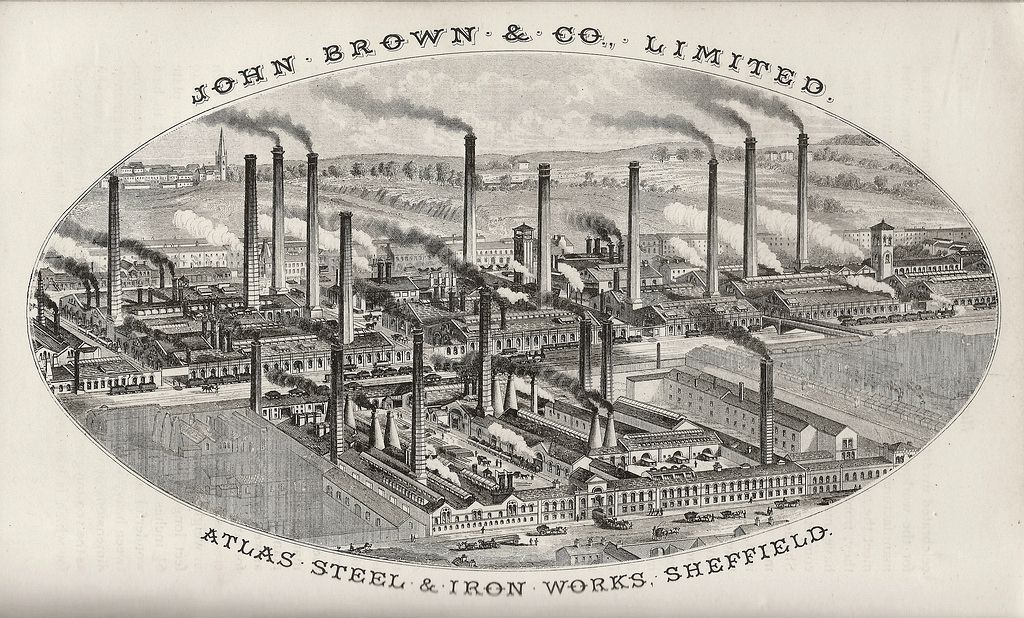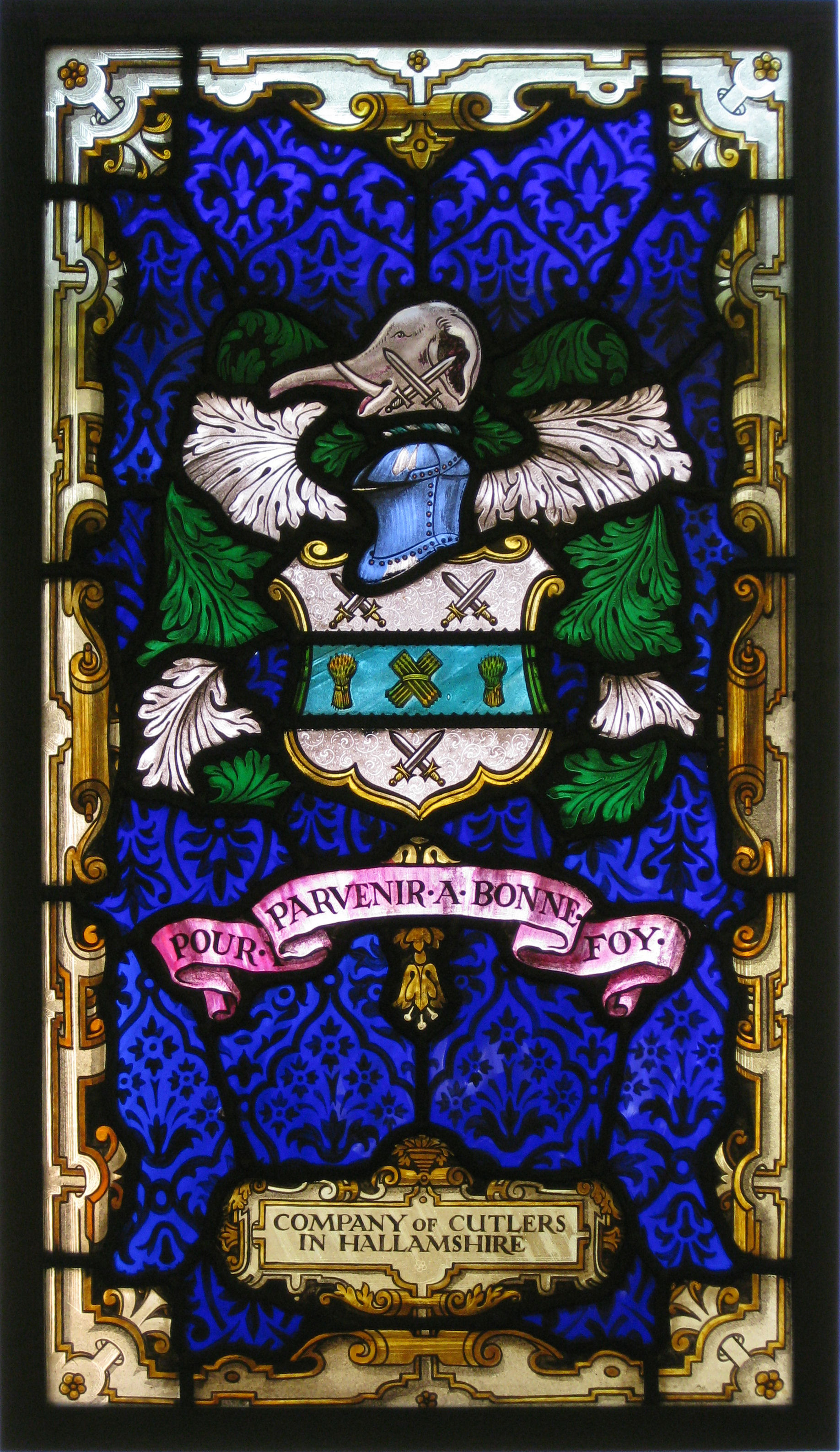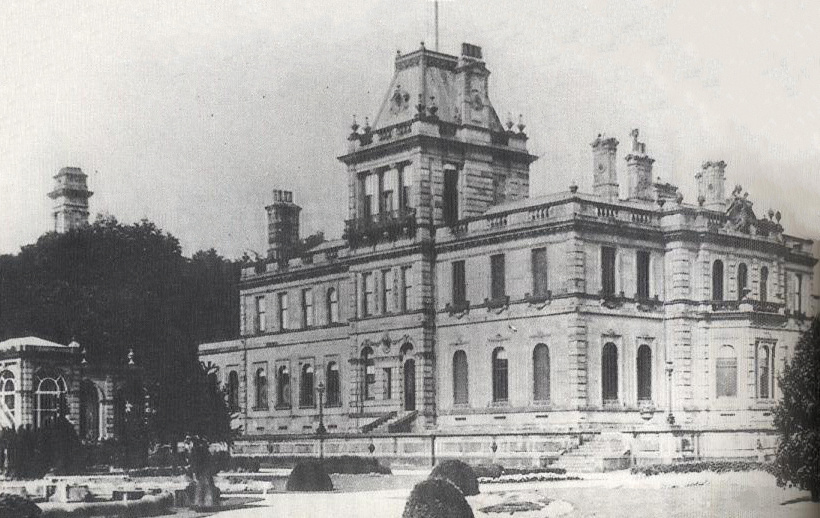|
John Brown (industrialist)
Sir John Brown (6 December 1816 – 27 December 1896), British industrialist, was born in Sheffield. He was known as the Father of the South Yorkshire Iron Trade. Background He was born at Sheffield in Flavell's Yard, Fargate, on 6 December 1816. He was the second son of Samuel Brown, a slater of that town. He was educated at a local school held in a garret, and was apprenticed at the age of fourteen to Earl, Horton, & Co., factors, of Orchard Place, In 1831, his employers engaged in the manufacture of files and table cutlery, taking an establishment in Rockingham Street, which they styled the Hallamshire Works. Nonetheless he did take over the company's factoring business with the help of a loan for £500 thanks to the backing of his father and uncle and for several years travelled the country selling goods.''"Aspects of Sheffield 1"'', Melvyn Jones (Editor), , Chapter "Endcliffe Hall: A Gentleman Industrialist Residence” by Julie Goddard Gives biography of Brown. In ... [...More Info...] [...Related Items...] OR: [Wikipedia] [Google] [Baidu] |
Sheffield
Sheffield is a city status in the United Kingdom, city in South Yorkshire, England, whose name derives from the River Sheaf which runs through it. The city serves as the administrative centre of the City of Sheffield. It is Historic counties of England, historically part of the West Riding of Yorkshire and some of its southern suburbs were transferred from Derbyshire to the city council. It is the largest settlement in South Yorkshire. The city is in the eastern foothills of the Pennines and the valleys of the River Don, Yorkshire, River Don with its four tributaries: the River Loxley, Loxley, the Porter Brook, the River Rivelin, Rivelin and the River Sheaf, Sheaf. Sixty-one per cent of Sheffield's entire area is green space and a third of the city lies within the Peak District national park. There are more than 250 parks, woodlands and gardens in the city, which is estimated to contain around 4.5 million trees. The city is south of Leeds, east of Manchester, and north ... [...More Info...] [...Related Items...] OR: [Wikipedia] [Google] [Baidu] |
La Gloire
The French ironclad ''Gloire'' (, "Glory") was the first ocean-going ironclad, launched in 1859. It was developed after the Crimean War,The Battle of Sinop at the start of the war convinced the world's naval powers that wooden warships could not withstand the new weapons. in response to new developments of naval gun technology, especially the Paixhans guns and rifled guns, which used explosive shells with increased destructive power against wooden ships, and after the development of the ironclad floating batteries built by the British and French for the bombardment of Russian forts during the Crimean War. Design and description ''Gloire'' was designed by the French naval architect Henri Dupuy de Lôme as a 5,630-ton broadside ironclad with a wooden hull. Its 12 cm-thick (4.7 in) armour plates, backed with 43 cm (17 in) of timber, resisted hits by the experimental shooting of the strongest guns of the time (the French 50-pounder and the British 68-pounder) ... [...More Info...] [...Related Items...] OR: [Wikipedia] [Google] [Baidu] |
Lord Mayors Of Sheffield
Lord is an appellation for a person or deity who has authority, control, or power over others, acting as a master, chief, or ruler. The appellation can also denote certain persons who hold a title of the peerage in the United Kingdom, or are entitled to courtesy titles. The collective "Lords" can refer to a group or body of peers. Etymology According to the Oxford Dictionary of English, the etymology of the word can be traced back to the Old English word ''hlāford'' which originated from ''hlāfweard'' meaning "loaf-ward" or "bread-keeper", reflecting the Germanic tribal custom of a chieftain providing food for his followers. The appellation "lord" is primarily applied to men, while for women the appellation "lady" is used. This is no longer universal: the Lord of Mann, a title previously held by the Queen of the United Kingdom, and female Lords Mayor are examples of women who are styled as "Lord". Historical usage Feudalism Under the feudal system, "lord" had a wide ... [...More Info...] [...Related Items...] OR: [Wikipedia] [Google] [Baidu] |
1896 Deaths
Events January–March * January 2 – The Jameson Raid comes to an end, as Jameson surrenders to the Boers. * January 4 – Utah is admitted as the 45th U.S. state. * January 5 – An Austrian newspaper reports that Wilhelm Röntgen has discovered a type of radiation (later known as X-rays). * January 6 – Cecil Rhodes is forced to resign as Prime Minister of the Cape of Good Hope, for his involvement in the Jameson Raid. * January 7 – American culinary expert Fannie Farmer publishes her first cookbook. * January 12 – H. L. Smith takes the first X-ray photograph. * January 17 – Fourth Anglo-Ashanti War: British redcoats enter the Ashanti capital, Kumasi, and Asantehene Agyeman Prempeh I is deposed. * January 18 – The X-ray machine is exhibited for the first time. * January 28 – Walter Arnold, of East Peckham, Kent, England, is fined 1 shilling for speeding at (exceeding the contemporary speed limit of , the first sp ... [...More Info...] [...Related Items...] OR: [Wikipedia] [Google] [Baidu] |
1816 Births
This year was known as the ''Year Without a Summer'', because of low temperatures in the Northern Hemisphere, possibly the result of the Mount Tambora volcanic eruption in Indonesia in 1815, causing severe global cooling, catastrophic in some locations. Events January–March * December 25 1815–January 6 – Tsar Alexander I of Russia signs an order, expelling the Jesuits from St. Petersburg and Moscow. * January 9 – Sir Humphry Davy's Davy lamp is first tested underground as a coal mining safety lamp, at Hebburn Colliery in northeast England. * January 17 – Fire nearly destroys the city of St. John's, Newfoundland. * February 10 – Friedrich Karl Ludwig, Duke of Schleswig-Holstein-Sonderburg-Beck, dies and is succeeded by Friedrich Wilhelm, his son and founder of the House of Glücksburg. * February 20 – Gioachino Rossini's opera buffa ''The Barber of Seville'' premières at the Teatro Argentina in Rome. * March 1 – The Gork ... [...More Info...] [...Related Items...] OR: [Wikipedia] [Google] [Baidu] |
19th-century English Businesspeople
The 19th (nineteenth) century began on 1 January 1801 ( MDCCCI), and ended on 31 December 1900 ( MCM). The 19th century was the ninth century of the 2nd millennium. The 19th century was characterized by vast social upheaval. Slavery was abolished in much of Europe and the Americas. The First Industrial Revolution, though it began in the late 18th century, expanding beyond its British homeland for the first time during this century, particularly remaking the economies and societies of the Low Countries, the Rhineland, Northern Italy, and the Northeastern United States. A few decades later, the Second Industrial Revolution led to ever more massive urbanization and much higher levels of productivity, profit, and prosperity, a pattern that continued into the 20th century. The Islamic gunpowder empires fell into decline and European imperialism brought much of South Asia, Southeast Asia, and almost all of Africa under colonial rule. It was also marked by the collapse of the large ... [...More Info...] [...Related Items...] OR: [Wikipedia] [Google] [Baidu] |
John Brown & Company
John Brown and Company of Clydebank was a Scottish Naval architecture, marine engineering and shipbuilding firm. It built many notable and world-famous ships including , , , , , and the ''Queen Elizabeth 2 (ship), Queen Elizabeth 2''. At its height, from 1900 to the 1950s, it was one of the most highly regarded, and internationally famous, shipbuilding companies in the world. However thereafter, along with other UK shipbuilders, John Brown's found it increasingly difficult to compete with the emerging shipyards in Eastern Europe and the far East. In 1968 John Brown's merged with other Clydeside shipyards to form the Upper Clyde Shipbuilders consortium, but that collapsed in 1971. The company then withdrew from shipbuilding but its engineering arm remained successful in the manufacture of industrial gas turbines. In 1986 it became a wholly owned subsidiary of Trafalgar House (company), Trafalgar House, which in 1996 was taken over by Kvaerner. The latter closed the Clydebank en ... [...More Info...] [...Related Items...] OR: [Wikipedia] [Google] [Baidu] |
Firth Brown Steels
Firth Brown Steels was initially formed in 1902, when Sheffield steelmakers John Brown & Company exchanged shares and came to a working agreement with neighbouring company Thomas Firth & Sons. In 1908 the two companies came together and established the Brown Firth Research Laboratories and it was here, in 1912, under the leadership of Harry Brearley they developed high chrome stainless steel. The companies continued under their own management until they formally merged in 1930 becoming Firth Brown Steels. The company is now part of Sheffield Forgemasters. History of John Brown and Company John Brown founded his company in the 1840s to manufacture steel files. Over the years the emphasis moved to the manufacture of railway track, made from steel provided by the new Bessemer process, and later to rail coach springs. Shipcladding and shipbuilding interests came into the company portfolio and finally, in the 1950s, general construction. Following an eight-year role in successf ... [...More Info...] [...Related Items...] OR: [Wikipedia] [Google] [Baidu] |
Flockton (architects)
Flockton's were a series of architectural firms in the 19th and early 20th centuries, based in Sheffield, England England is a country that is part of the United Kingdom. It shares land borders with Wales to its west and Scotland to its north. The Irish Sea lies northwest and the Celtic Sea to the southwest. It is separated from continental Europe b .... The firms were responsible for a number of significant buildings, particularly in the Sheffield area. William Flockton William Flockton (1804–1864) was the son of Thomas Flockton, a carpenter and builder in Sheffield. He was brought up in his father's trade and established himself as an architect in 1833. From 1845 to 1849 he operated the business with William Lee and his son Thomas James Flockton as ''Flockton, Lee and Flockton'', continuing in partnership with Thomas James Flockton as ''Flockton & Son'' until his death on 24 September 1864. Buildings Thomas James Flockton Thomas James Flockton (1823–1899), th ... [...More Info...] [...Related Items...] OR: [Wikipedia] [Google] [Baidu] |
Company Of Cutlers In Hallamshire
The Company of Cutlers in Hallamshire is a trade guild of metalworkers based in Sheffield, England. It was incorporated in 1624 by an Act of Parliament. The head is called the Master Cutler. Its motto is french: 1=Pour Y Parvenir a Bonne Foi, links=yes, lit=To Succeed through Honest Endeavour. In the original act of Parliament, the company was given jurisdiction over: :"all persons using to make Knives, Blades, Scissers, Sheeres, Sickles, Cutlery wares and all other wares and manufacture made or wrought of yron and steele, dwelling or inhabiting within the said Lordship and Liberty of Hallamshire, or within six miles compasse of the same".Sheffield Records Online Sheffield Master Cutlers and Apprentices [...More Info...] [...Related Items...] OR: [Wikipedia] [Google] [Baidu] |
Lord Mayor Of Sheffield
The Lord Mayor of Sheffield is a ceremonial post held by a member of Sheffield City Council. They are elected annually by the council. The post originated in 1843, with the appointment of William Jeffcock as the first Mayor of Sheffield. Early mayors had significant powers and chaired both council meetings and the bench of magistrates. In 1855, the then-mayor was refused a good seat at the opening of the Paris Exhibition, as he did not have a chain of office. As a result, one was purchased the following year, and this has remained in use. In 1897, in the same year as the opening of Sheffield Town Hall, the mayor was given the right to style himself the " Lord Mayor". To mark this, the first Lord Mayor, Henry Fitzalan-Howard, 15th Duke of Norfolk, gave the Sheffield Mace to the city to mark the royal authority invested in the post. The Lord Mayor has the use of the Lord Mayor's Parlour in Sheffield Town Hall, an official badge and the honorary presidency of several orga ... [...More Info...] [...Related Items...] OR: [Wikipedia] [Google] [Baidu] |
Endcliffe Hall
Endcliffe Hall is a 19th-century, 36-room mansion situated on Endcliffe Vale Road in the City of Sheffield in the suburb of Endcliffe. The hall is situated just over west of the city centre and is a Grade II* Listed building. The present hall was built between the years of 1863 and 1865 by the Sheffield architects Flockton & Abbot for the Sheffield industrialist John Brown. Brown had acquired considerable wealth and prestige from the manufacture of armour plate from Bessemer steel at his Atlas Works in the city and wanted to build a private residence to reflect his position as one of the Nouveau riche industrialist of the Victorian Age. It is the largest private residence ever to have been built in Sheffield. History The Endcliffe estate can be traced back to 1333 when John de Elcliffe was awarded a financial grant, at that time the estate extended considerably and took in land between the Porter and Sheaf valleys. It is believed that the first Endcliffe Hall was built in th ... [...More Info...] [...Related Items...] OR: [Wikipedia] [Google] [Baidu] |



.jpg)






